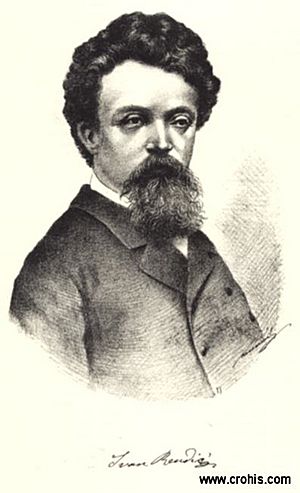Ivan Rendić facts for kids
Quick facts for kids
Ivan Rendić
|
|
|---|---|

Ivan Rendić, Croatian sculptor
|
|
| Born | 27 August 1849 Imotski, Croatia
|
| Died | 29 June 1932 (aged 82) |
| Nationality | Croatian |
| Education | Venice, Florence |
| Known for | Sculpture |
|
Notable work
|
Andrija Medulić, Julije Klović, Krsto I Frankopan, Ivan Gundulić, Nikola Jurišić and August Šenoa at Zrinjevac park in Zagreb, as well as Petar Preradović, Andrija Kačić Miošić also in Zagreb, Ljudevit Gaj in Krapina etc. |
| Movement | Realism |
Ivan Rendić (born August 27, 1849, died June 29, 1932) was a very important Croatian sculptor. He was the first famous Croatian sculptor of the modern age who received formal training. He created many beautiful statues, especially monuments to important Croatian people.
His Life and Work
Ivan Rendić started sculpting when he was young. He grew up on the island of Brač, which was known for its stoneworking. This helped him learn about working with stone early on.
He went to art school in Venice and finished in 1871. After that, he joined a sculpting studio in Florence. Later, he mostly lived and worked in Trieste, where he made most of his artworks. In Croatia, many of his works can be seen in Zagreb and Split.
Rendić was the first well-known and formally trained Croatian sculptor of the modern era. He worked in a style called Realism. This means his sculptures looked very much like real life, often with many fine details.
Famous Sculptures
Ivan Rendić made about 200 statues during his life. His most famous works are public monuments. These are statues placed in public places to honor important Croats. You can find his sculptures all over Croatia.
For example, in Zrinjevac park in Zagreb, you can see his statues of:
- Andrija Medulić
- Julije Klović
- Krsto I Frankopan
- Ivan Gundulić
- Nikola Jurišić
- August Šenoa
He also made statues of Petar Preradović and Andrija Kačić Miošić in Zagreb. Another famous work is the statue of Ljudevit Gaj in Krapina. In Supetar, he created busts (head and shoulders sculptures) of people like Eugen Kumičić and Emperor Franz Joseph I.
Later Years
From 1921, Ivan Rendić lived in Supetar. He tried to start an art school there, but it didn't work out. He sadly ended his life in poverty.
While he worked in Trieste, Rendić faced challenges. He supported the idea of Dalmatia joining the rest of Croatia. Because of this, some groups who wanted Trieste to be part of Italy were against him and his work.
Images for kids







